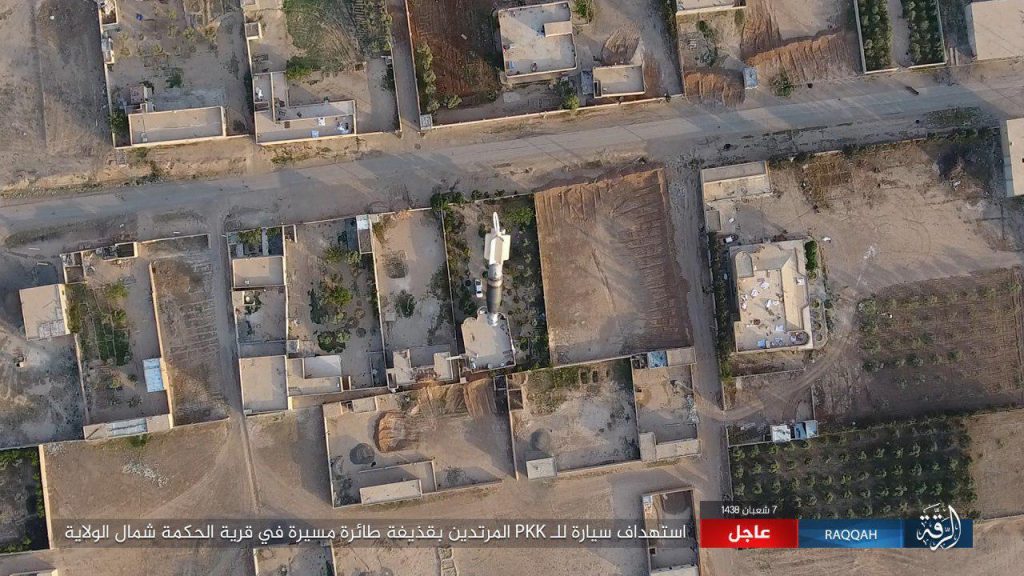
The Islamic State drops a small bomb from a modified drone in Raqqa province.
The US-led coalition announced today that “three senior and highly skilled ISIS officials” were killed in airstrikes near Mayadin, Syria between Sept. 12 and 14. All three were “drone experts” responsible for weaponizing small drones, which the Islamic State has deployed throughout Iraq and Syria.
Mayadin, a city on the Euphrates River in the eastern Syrian province of Deir Ezzor, is a major hub for the so-called caliphate’s leadership. The group transferred key personnel to Mayadin and other locales along the Syrian-Iraqi border as it lost ground elsewhere.
The US has conducted a targeted air campaign against senior Islamic State figures in and around Mayadin since earlier this year. The importance of the area to the Islamic State can be seen in the key roles played by the jihadists hunted down inside the city and the surrounding villages.
Prior to today’s announcement, the US identified 14 key leaders who have been taken out in the precision bombings since April. In some cases, their unnamed associates and perhaps some civilians perished as well. The deceased jihadists include one of Baghdadi’s most senior lieutenants, a top ideologue, weapons engineers, propagandists and “external operations” planners. External attacks target the West and other areas outside of the Islamic State’s strongholds.
[For more on the targeted air campaign in and around Mayadin, see FDD’s Long War Journal report, US says 2 more senior Islamic State leaders killed near Mayadin, Syria.]
The three recently departed Islamic State operatives are Abu Salman, Abu Muadh al-Tunisi and Sajid Farooq Babar, according to Combined Joint Task Force – Operation Inherent Resolve (CJTF-OIR).
Abu Salman was “an ISIS drone developer” and ran a “research workshop” in Asharah, a village near Mayadin. He was killed during airstrikes on Sept. 14 “while traveling with a terrorist associate in a vehicle from Mayadin to Asharah,” CJTF-OIR announced. “His death and the destruction of his drone facility greatly disrupts ISIS’ development of weaponized drones and testing of new software.”
Abu Muadh al-Tunisi and Sajid Farooq Babar were killed near Mayadin “on Sept. 12 and 13, respectively” and “were responsible for manufacturing and modifying commercially produced drones.” Abu Muadh’s alias indicates that he was likely from Tunisia.
The Islamic State increasingly relied on modified drones as it came under siege in Iraq and Syria. The deputy commander of CJTF-OIR, British Army Maj. Gen. Rupert Jones, explained in February that the jihadists use the drones for surveillance and also to drop munitions on various targets.
The self-declared caliphate has produced numerous videos and other images of its drones in action. The footage often highlights small munitions being dropped on Coalition-backed forces. But officials have emphasized that the drones hit civilians as well. “While this is a typically inhumane and indiscriminate weapon by [ISIS],” Jones said earlier this year, “it’s not a game-changer. We’ve got technical defenses to mitigate against it.”
Regardless, the anti-ISIS Coalition has been forced to devote resources to tracking and eliminating the threat posed by the jihadists’ improvised aerial weapons. Junaid ur Rehman, another Islamic State operative killed in Ashara (south of Mayadin) earlier this month, was also weaponizing drones “to conduct aerial surveillance on the battlefield.”
“The removal of these key ISIS leaders disrupts and degrades ISIS’ ability to modify and employ drone platforms as reconnaissance and direct fire weapons on the battlefield,” Coalition Spokesman Col. Ryan Dillon stated in CJTF-OIR’s press release today.
As FDD’s Long War Journal has noted previously, Mayadin is not the only remaining hotspot for the Islamic State’s leadership. The US-led air campaign has focused on personnel in other locations along the border of Iraq and Syria this year, including in Al-Qaim, Abu Kamal and elsewhere in Deir Ezzor province.
But it is clear that Mayadin has emerged as one of the most important locales in the self-declared caliphate’s shrinking territory. In addition to senior personnel, the US has repeatedly targeted the Islamic State’s oil trucks and wells near the city.








3 Comments
Killing them? What a waste of talent. Let Jeff Bezos de-radicalize them, using them in developing his product-delivery-by-drone system.
/ <–sarc tag
It’s like shooting fish in a barrel now for the “coalition”. ISIS has been squeezed from all sides and there is nowhere to get away. They still have a large amount of weaponry left but they’re running out of live bodies. ISIS in Iraq is crumbling fast and appear to be headed to Mayadin. Judging by the counteroffensive they just hurled against the Palmyra-Deir ezzor highway. They intend use ALL their equipment and bodies before they’re done.
Ha! Hey, wait. I laughed at your sarcasm, but then I realized: that’s how we got to the moon. Reappropriated and de-radicalized Nazi scientists, and called them German defectors. Also kinda like hackers getting a job with software companies.
Thanks for the chuckle.
JB